Spatio-Temporal Variation Analysis of Soil Salinization in the Ougan-Kuqa River Oasis of China
Abstract
:1. Introduction
- (1)
- A new approach has been developed to combine spectral indices and various environmental covariates such as meteorology, terrain data, and soil attributes, with the aim of enhancing the accuracy and reliability of soil salinity monitoring.
- (2)
- The Boruta and ReliefF algorithms are employed to improve the feature selection process by reducing its complexity, thereby significantly enhancing the functionality and predictive accuracy of the models.
- (3)
- Based on the selected features, LightGBM, ELM, and SVM methods are employed to develop soil salinity inversion models to assess the influence of diverse input variables and modeling approaches on the accuracy of the salinity inversion models and to subsequently generate a map depicting the distribution of soil electrical conductivity in the Ogan-Kuqa River Oasis, Xinjiang, China.
- (4)
- The Multiscale Geographically Weighted Regression model (MGWR) is employed to examine the temporal-spatial variability of environmental factors impacting soil salinity, which contributes to a more thorough comprehension of the temporal-spatial distribution patterns of soil salinity and the complex dynamics of soil salinization influenced by a variety of environmental factors.
2. Materials and Methods
2.1. Study Area and Data Acquisition
2.1.1. Study Area
2.1.2. Soil Sampling and Analysis
2.1.3. Acquisition and Pre-Processing of Remote Sensing Data
2.1.4. Environmental Covariates
2.2. Covariate Selection Algorithm
2.2.1. Boruta
2.2.2. ReliefF
2.3. Model Construction and Accuracy Evaluation
2.3.1. LightGBM
2.3.2. Extreme Learning Machine
2.3.3. Support Vector Machine
2.3.4. Accuracy Evaluation
2.4. Multiscale Geographically Weighted Regression
3. Results
3.1. Descriptive Statistics of Soil EC
3.2. Correlation Analysis
3.3. Selection of Environmental Covariates and Bands
3.3.1. Results of Boruta-Based Feature Selection
3.3.2. Results of ReliefF-Based Feature Selection
3.4. Building and Validating the Soil Electrical Conductivity Inversion Model
3.5. Soil EC Mapping
3.6. The Influence of Temporal-Spatial Variability on Environmental Factors
4. Discussion
- (1)
- Red-edge band indices, calculated by substituting original red bands, are more sensitive to salinity compared to vegetation indices derived from the original red bands. These red-edge indices are frequently identified as important variables in both selection algorithms, likely related to potential spectral information and a higher signal-to-noise ratio in the red-edge region [24].
- (2)
- In predicting salinity, terrain indices rank lowest in relevance and importance. Only the aspect (Aspect) has a positive correlation with soil electrical conductivity (EC) and meets the criterion for an important variable in both selection methods. This is due to the study area’s relatively flat topography, which does not effectively correlate with the spatio-temporal distribution of soil salinity [45]. Aspect influences salinization mainly through changes in sunlight exposure, with sunny slopes having longer sunlight exposure and higher soil moisture evaporation than shady slopes, thus enhancing soil salinization. Yet, this factor also requires consideration of seasonal changes and vegetation coverage [46].
- (3)
- In both feature selection methods, soil organic carbon (SOC) and cation exchange capacity (CEC) emerge as significant. Soil organic carbon (SOC), part of soil organic matter, supplies plant nutrients and augments the soil’s capacity to adsorb cations (such as Na+, Ca2+, etc.) [47]. The cation exchange capacity (CEC) of soil is the number of cations that soil colloids can adsorb on their surfaces. Therefore, when the soil colloids’ capacity to adsorb cations increases, the soil’s salinity content decreases. Variations in soil cation exchange capacity (CEC) impact the pH and electrical conductivity of soil moisture, which in turn affects the adsorption and desorption of ions in the soil, further influencing soil salinity content.
5. Conclusions
- (1)
- Conducting variable selection before building soil salinity inversion models enhances model performance and prediction accuracy, efficiently reduces data dimensions, and thus helps identify the key variables most impacting the target variable, leading to a deeper understanding of the data–model relationship. Among six environmental covariates, Red-Edge band indices hold the highest importance, and terrain indices the least.
- (2)
- With varying numbers of input variables in the model, the modeling strategy based on Boruta-LightGBM exhibits optimal performance, accounting for 65% to 77% of the spatio-temporal variation in soil electrical conductivity (EC).
- (3)
- In the study area, soil salinity exhibits a trend of gradually increasing from northwest to southeast. The respective proportions of non-saline soil, light salinization, moderate salinization, severe salinization, and saline soil are 37%, 19%, 13%, 20%, and 11%.
- (4)
- MGWR findings show that soc, PRE, PH, and TEM significantly impact soil electrical conductivity (EC) in the study area and exhibit notable spatio-temporal differences. In the Ogan-Kuqa River basin area of the study, the Stream Power Index (SPI) significantly affects soil electrical conductivity (EC), and within the oases, the cation exchange capacity (cec) exerts a strong negative influence on soil electrical conductivity (EC).
Author Contributions
Funding
Institutional Review Board Statement
Informed Consent Statement
Data Availability Statement
Acknowledgments
Conflicts of Interest
References
- Zinck, G.I.M.A. Remote sensing of soil salinity: Potentials and constraints. Remote Sens. Environ. 2003, 25, 1–20. [Google Scholar]
- Weng, B.; Zheng, X. Thinking and Countermeasures for Rational Utilization of Soil Fertility in Modern Agriculture Developping. J. Agric. Resour. Environ. 2014, 405, 1875. [Google Scholar]
- Ivushkin, K.; Bartholomeus, H.; Bregt, A.K.; Pulatov, A.; Sousa, L.D. Global mapping of soil salinity change. Remote Sens. Environ. 2019, 231, 111260. [Google Scholar] [CrossRef]
- An, D.; Zhao, G.; Chang, C.; Wang, Z.; Li, P.; Zhang, T.; Jia, J. Hyperspectral field estimation and remote-sensing inversion of salt content in coastal saline soils of the Yellow River Delta. Int. J. Remote Sens. 2016, 37, 455–470. [Google Scholar] [CrossRef]
- Nwer, B.; Zurqani, H.; Rhoma, E. The Use of Remote Sensing and Geographic Information System for Soil Salinity Monitoring in Libya. GSTF J. Geol. Sci. 2013, 1, 38–42. [Google Scholar] [CrossRef] [PubMed]
- Ge, X.; Ding, J.; Teng, D.; Wang, J.; Huo, T.; Jin, X.; He, B.; Han, L. Updated soil salinity with fine spatial resolution and high accuracy: The synergy of Sentinel-2 MSI, environmental covariates and hybrid machine learning approaches. Catena Interdiscip. J. Soil Sci. Hydrol.-Geomorphol. Focus. Geoecology Landsc. Evol. 2022, 212, 106054. [Google Scholar] [CrossRef]
- Ijaz, Z.; Zhao, C.; Ijaz, N.; Rehman, Z.U.; Ijaz, A. Novel application of Google earth engine interpolation algorithm for the development of geotechnical soil maps: A case study of mega-district. Geocarto Int. 2022, 37, 18196–18216. [Google Scholar] [CrossRef]
- Ijaz, Z.; Zhao, C.; Ijaz, N.; Rehman, Z.U.; Ijaz, A. Spatial mapping of geotechnical soil properties at multiple depths in Sialkot region, Pakistan. Environ. Earth Sci. 2021, 80, 787. [Google Scholar] [CrossRef]
- Shi, T.; Wang, J.; Liu, H.; Chen, Y.; Wu, G. Soil Organic Carbon Content Estimation with Laboratory-Based Visible-Near-Infrared Reflectance Spectroscopy: Feature Selection. Appl. Spectrosc. Soc. Appl. Spectrosc. 2014, 68, 831–837. [Google Scholar] [CrossRef] [PubMed]
- Taghizadeh-Mehrjardi, R.; Minasny, B.; Sarmadian, F.; Malone, B.P. Digital mapping of soil salinity in Ardakan region, central Iran. Geoderma 2014, 213, 15–28. [Google Scholar] [CrossRef]
- Qian, Z.; Jianli, D.; Xiangyu, G.; Ke, L.; Zipeng, Z.; Yongsheng, G. Estimation of soil organic matter in the Ogan-Kuqa River Oasis, Northwest China, based on visible and near-infrared spectroscopy and machine learning. J. Arid Land 2023, 15, 191–204. [Google Scholar]
- Luo, C.; Zhang, X.; Wang, Y.; Men, Z.; Liu, H. Regional soil organic matter mapping models based on the optimal time window, feature selection algorithm and Google Earth Engine. Soil Tillage Res. 2022, 219, 105325. [Google Scholar] [CrossRef]
- Mohamed, S.A.; Metwaly, M.M.; Metwalli, M.R.; AbdelRahman, M.A.; Badreldin, N. Integrating Active and Passive Remote Sensing Data for Mapping Soil Salinity Using Machine Learning and Feature Selection Approaches in Arid Regions. Remote Sens. 2023, 15, 1751. [Google Scholar] [CrossRef]
- Wang, Y.; Xie, M.; Hu, B.; Jiang, Q.; Shi, Z.; He, Y.; Peng, J. Desert Soil Salinity Inversion Models Based on Field In Situ Spectroscopy in Southern Xinjiang, China. Remote Sens. 2022, 14, 4962. [Google Scholar] [CrossRef]
- Xinsheng, Z.; Baoshan, C.; Tao, S. The relationship between the spatial distribution of vegetation and soil environmental factors in the tidal creek areas of the Yellow River Delta. Ecol. Environ. Sci. 2010, 19, 1855–1861. [Google Scholar]
- Matteo, P.; Silvia, C.; Giancarlo, P.; Michele, P. Modelling and mapping Soil Organic Carbon in annual cropland under different farm management systems in the Apulia region of Southern Italy. Soil Tillage Res. 2024, 235, 105916. [Google Scholar]
- Zhang, Y.; Wang, Y.; Bai, Y.; Zhang, R.; Liu, X.; Ma, X. Prediction of Spatial Distribution of Soil Organic Carbon in Helan Farmland Based on Different Prediction Models. Land 2023, 12, 1984. [Google Scholar] [CrossRef]
- Ye, H.; Huang, W.; Huang, S.; Huang, Y.; Zhang, S.; Dong, Y.; Chen, P. Effects of different sampling densities on geographically weighted regression kriging for predicting soil organic carbon. Spat. Stat. 2017, 20, 76–91. [Google Scholar] [CrossRef]
- Hojjatollah, M.; Alireza, S.; Babak, M. Improving groundwater nitrate concentration prediction using local ensemble of machine learning models. J. Environ. Manag. 2023, 345, 118782. [Google Scholar]
- Jiang, Z.; Xu, B. Geographically weighted regression analysis of the spatially varying relationship between farming viability and contributing factors in Ohio. Reg. Sci. Policy Pract. 2014, 6, 69–83. [Google Scholar] [CrossRef]
- Fotheringham, A.S.; Yang, W.; Kang, W. Multiscale Geographically Weighted Regression (MGWR). Ann. Am. Assoc. Geogr. 2017, 107, 1247–1265. [Google Scholar] [CrossRef]
- Liu, F.; Wu, H.; Zhao, Y.; Li, D.; Yang, J.L.; Song, X.; Shi, Z.; Zhu, A.X.; Zhang, G.L. Mapping high resolution National Soil Information Grids of China. Sci. Bull. 2022, 67, 328–340. [Google Scholar] [CrossRef] [PubMed]
- Guolin, M.A.; Jianli, D.; Lijing, H.; Zipeng, Z.; Si, R. Digital mapping of soil salinization based on Sentinel-1 and Sentinel-2 data combined with machine learning algorithms. Reg. Sustain. 2021, 2, 177–188. [Google Scholar]
- Wang, J.; Ding, J.; Yu, D.; Ma, X.; Yu, D. Capability of Sentinel-2 MSI data for monitoring and mapping of soil salinity in dry and wet seasons in the Ebinur Lake region, Xinjiang, China. Geoderma 2019, 353, 172–187. [Google Scholar] [CrossRef]
- Ma, S.; He, B.; Xie, B.; Ge, X.; Han, L. Investigation of the spatial and temporal variation of soil salinity using Google Earth Engine: A case study at Werigan–Kuqa Oasis, West China. Sci. Rep. 2023, 13, 2754. [Google Scholar] [CrossRef] [PubMed]
- Tian, Y.C.; Yao, X.; Yang, J.; Cao, W.X.; Hannaway, D.B.; Zhu, Y. Assessing newly developed and published vegetation indices for estimating rice leaf nitrogen concentration with ground- and space-based hyperspectral reflectance. Field Crops Res. 2011, 120, 299–310. [Google Scholar] [CrossRef]
- Peng, S.; Ding, Y.; Liu, W.; Zhi, L.I. 1 km monthly temperature and precipitation dataset for China from 1901 to 2017. Earth Syst. Sci. Data 2019, 11, 1931–1946. [Google Scholar] [CrossRef]
- Peng, S.; Ding, Y.; Wen, Z.; Chen, Y.; Cao, Y.; Ren, J. Spatiotemporal change and trend analysis of potential evapotranspiration over the Loess Plateau of China during 2011–2100. Agric. For. Meteorol. 2017, 233, 183–194. [Google Scholar] [CrossRef]
- Kursa, M.B.; Rudnicki, W.R. Feature Selection with Boruta Package. J. Stat. Softw. 2010, 36, 1–13. [Google Scholar] [CrossRef]
- Gan, W.; Zhang, Y.; Xu, J.; Yang, R.; Xiao, A.; Hu, X. Spatial Distribution of Soil Heavy Metal Concentrations in Road-Neighboring Areas Using UAV-Based Hyperspectral Remote Sensing and GIS Technology. Sustainability 2023, 15, 10043. [Google Scholar] [CrossRef]
- Lawal, I.M.; Bertram, D.; White, C.J.; Kutty, S.R.M.; Hassan, I.; Jagaba, A.H. Application of Boruta algorithms as a robust methodology for performance evaluation of CMIP6 general circulation models for hydro-climatic studies. Theor. Appl. Climatol. 2023, 153, 113–135. [Google Scholar] [CrossRef]
- Kira, K.; Rendell, L.A. A Practical Approach to Feature Selection; Morgan Kaufmann Publishers Inc.: Cambridge, MA, USA, 1992. [Google Scholar]
- Xie, S.; Li, K.; Xiao, M.; Zhang, L.; Li, W. Key Quality Indicators Prediction for Web Browsing with Embedded Filter Feature Selection. Appl. Sci. 2020, 10, 2141. [Google Scholar] [CrossRef]
- Mahsa, H.; Abbas, M.; Reza, G. A Novel Scheme for Mapping of MVT-Type Pb–Zn Prospectivity: LightGBM, a Highly Efficient Gradient Boosting Decision Tree Machine Learning Algorithm. Nat. Resour. Res. 2023, 32, 2417–2438. [Google Scholar]
- Junting, Z.; Xiaoye, Z.; Ke, G.; Yaqiang, W.; Huizheng, C.; Xiaojing, S.; Lei, Z.; Yangmei, Z.; Junying, S.; Wenjie, Z. Robust prediction of hourly PM2.5 from meteorological data using LightGBM. Natl. Sci. Rev. 2021, 8, nwaa307. [Google Scholar]
- Jafar, A.; Golshan, M. Machine learning approaches for predicting arsenic adsorption from water using porous metal–organic frameworks. Sci. Rep. 2022, 12, 16458. [Google Scholar]
- Huang, G.B.; Zhou, H.; Ding, X.; Zhang, R. Extreme Learning Machine for Regression and Multiclass Classification. IEEE Trans. Syst. Man Cybern. Part B Cybern. 2012, 42, 513–529. [Google Scholar] [CrossRef] [PubMed]
- Yadav, B.; Ch, S.; Mathur, S.; Adamowski, J. Estimation of in-situ bioremediation system cost using a hybrid Extreme Learning Machine (ELM)-particle swarm optimization approach. J. Hydrol. 2016, 543, 373–385. [Google Scholar] [CrossRef]
- Kang, X.; Zhao, Y.; Li, J. Predicting refractive index of ionic liquids based on the extreme learning machine (ELM) intelligence algorithm. J. Mol. Liq. 2018, 250, 44–49. [Google Scholar] [CrossRef]
- Cortes, C.; Vapnik, V. Support-Vector Networks. Mach. Learn. 1995, 20, 273–297. [Google Scholar] [CrossRef]
- Ilyas, N.; Vasit, S.; Li, D.J.; Ümüt, H.; Abdulla, A.; Zaytungul, Y. A WFS-SVM Model for Soil Salinity Mapping in Keriya Oasis, Northwestern China Using Polarimetric Decomposition and Fully PolSAR Data. Remote Sens. 2018, 10, 598. [Google Scholar]
- Yang, S.H.; Liu, F.; Song, X.D.; Lu, Y.Y.; Li, D.C.; Zhao, Y.G.; Zhang, G.L. Mapping topsoil electrical conductivity by a mixed geographically weighted regression kriging: A case study in the Heihe River Basin, northwest China. Ecol. Indic. 2019, 102, 252–264. [Google Scholar] [CrossRef]
- Yuting, Z.; Kai, H.; Hui, Q.; Yanyan, G.; Yuan, F.; Shan, X.; Shunqi, T.; Qiying, Z.; Wengang, Q.; Wenhao, R. Characterization of soil salinization and its driving factors in a typical irrigation area of Northwest China. Sci. Total Environ. 2022, 837, 155808. [Google Scholar]
- Wang, J.; Shi, T.; Yu, D.; Teng, D.; Ge, X.; Zhang, Z.; Yang, X.; Wang, H.; Wu, G. Ensemble machine-learning-based framework for estimating total nitrogen concentration in water using drone-borne hyperspectral imagery of emergent plants: A case study in an arid oasis, NW China. Environ. Pollut. 2020, 266, 115412. [Google Scholar] [CrossRef] [PubMed]
- Phogat, V.; Pitt, T.; Petrie, P.; Šimůnek, J.; Cutting, M. Optimization of Irrigation of Wine Grapes with Brackish Water for Managing Soil Salinization. Land 2023, 12, 1947. [Google Scholar] [CrossRef]
- Mahdi, T.M.; Mahdi, H. Developing geographic weighted regression (GWR) technique for monitoring soil salinity using sentinel-2 multispectral imagery. Environ. Earth Sci. 2021, 80, 75. [Google Scholar]
- Salcedo, F.P.; Cutillas, P.P.; Cabañero, J.J.A.; Vivaldi, A.G. Use of remote sensing to evaluate the effects of environmental factors on soil salinity in a semi-arid area. Sci. Total Environ. 2021, 815, 152524. [Google Scholar] [CrossRef] [PubMed]
- Nazeer, M.; Bilal, M. Evaluation of Ordinary Least Square (OLS) and Geographically Weighted Regression (GWR) for Water Quality Monitoring: A Case Study for the Estimation of Salinity. J. Ocean Univ. China 2018, 17, 305–310. [Google Scholar] [CrossRef]
- Zeng, C.; Yang, L.; Zhu, A.-X.; Rossiter, D.G.; Liu, J.; Liu, J.; Qin, C.; Wang, D. Mapping soil organic matter concentration at different scales using a mixed geographically weighted regression method. Geoderma 2016, 281, 69–82. [Google Scholar] [CrossRef]
- Shuangyin, Z.; Yiyun, C.; Zheyue, Z.; Siying, W.; Zihao, W.; Yongsheng, H.; Yan, W.; Haobo, H.; Zhongzheng, H.; Teng, F. VNIR estimation of heavy metals concentrations in suburban soil with multi-scale geographically weighted regression. Catena 2022, 219, 106585. [Google Scholar]
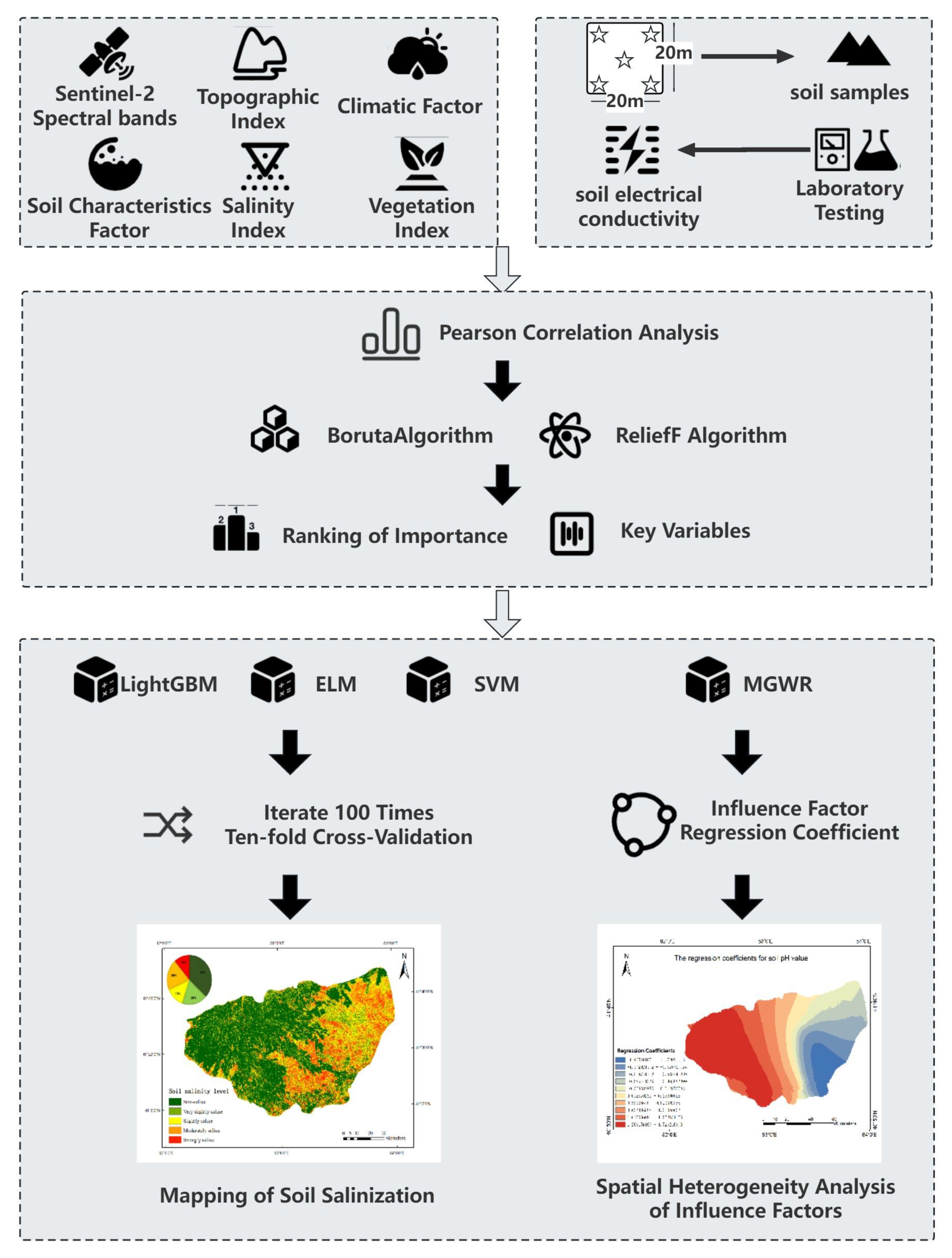

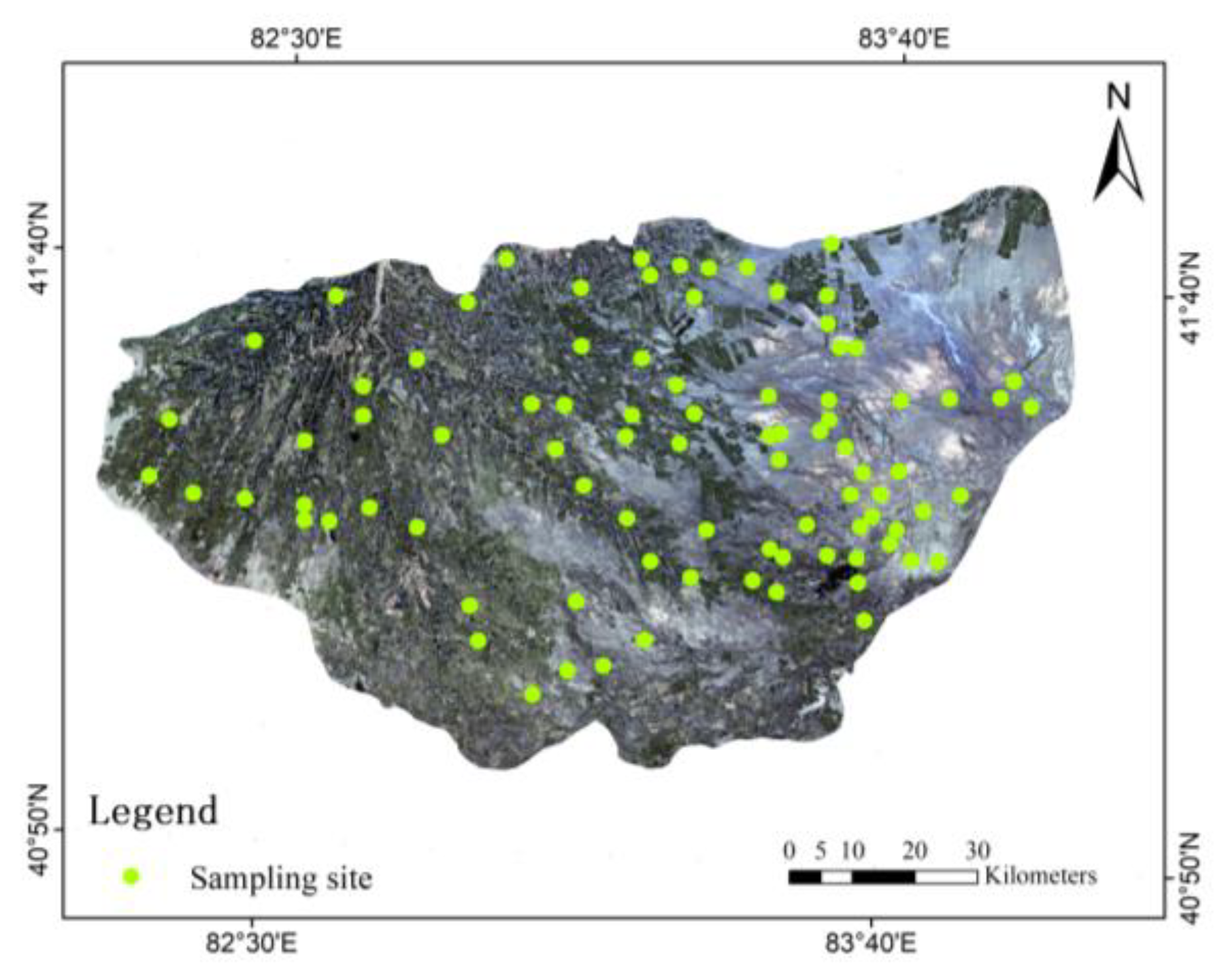
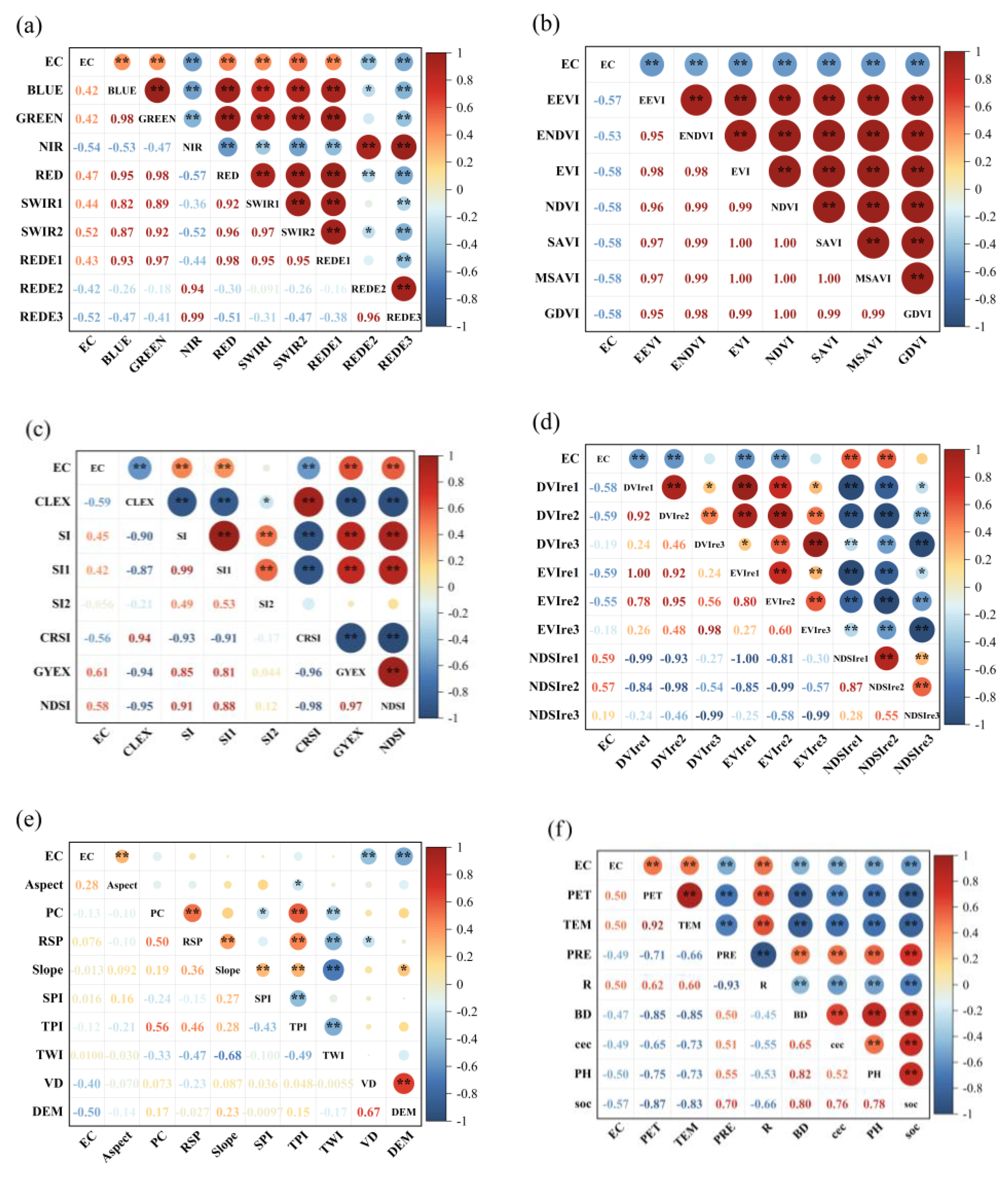

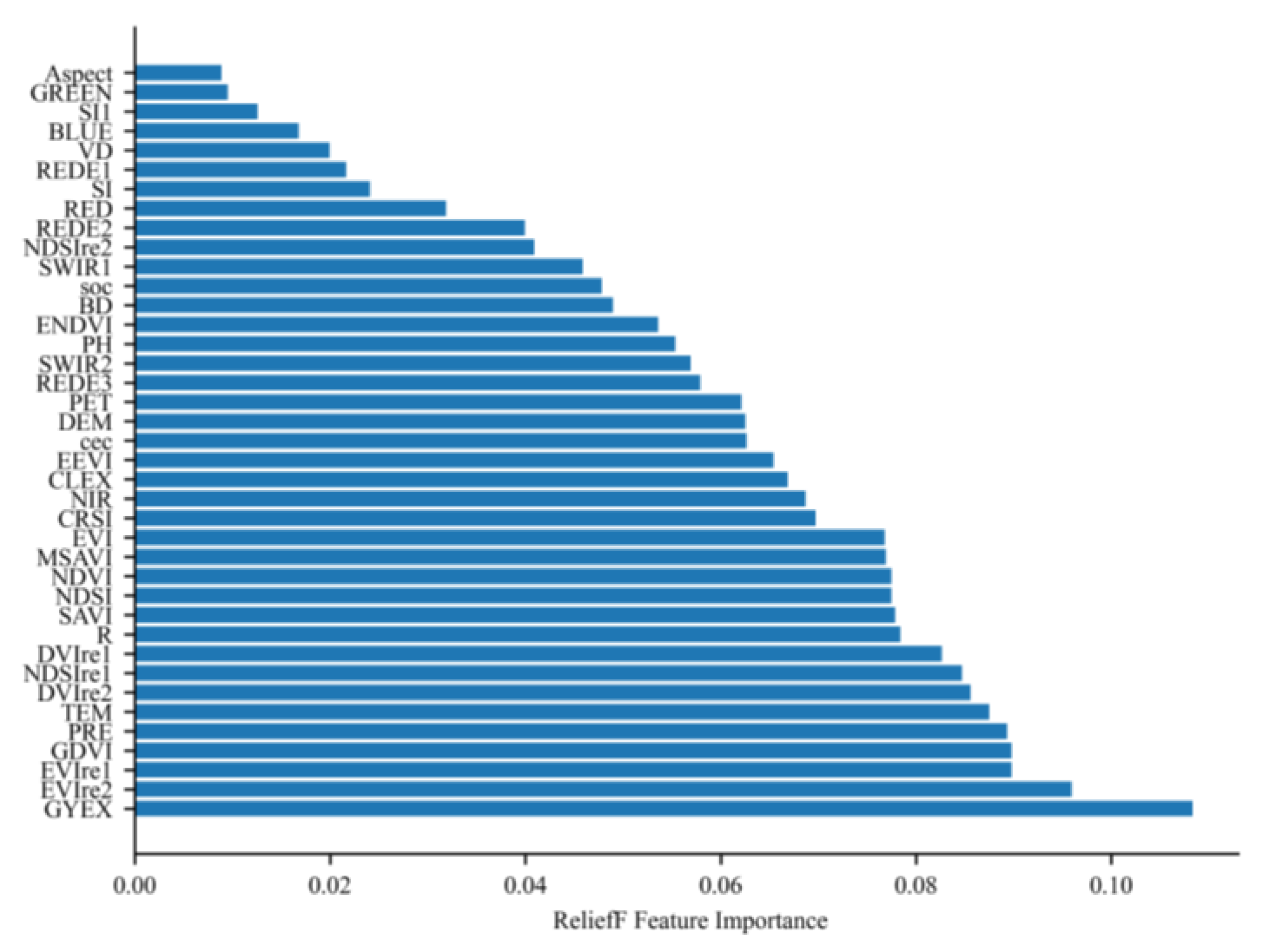

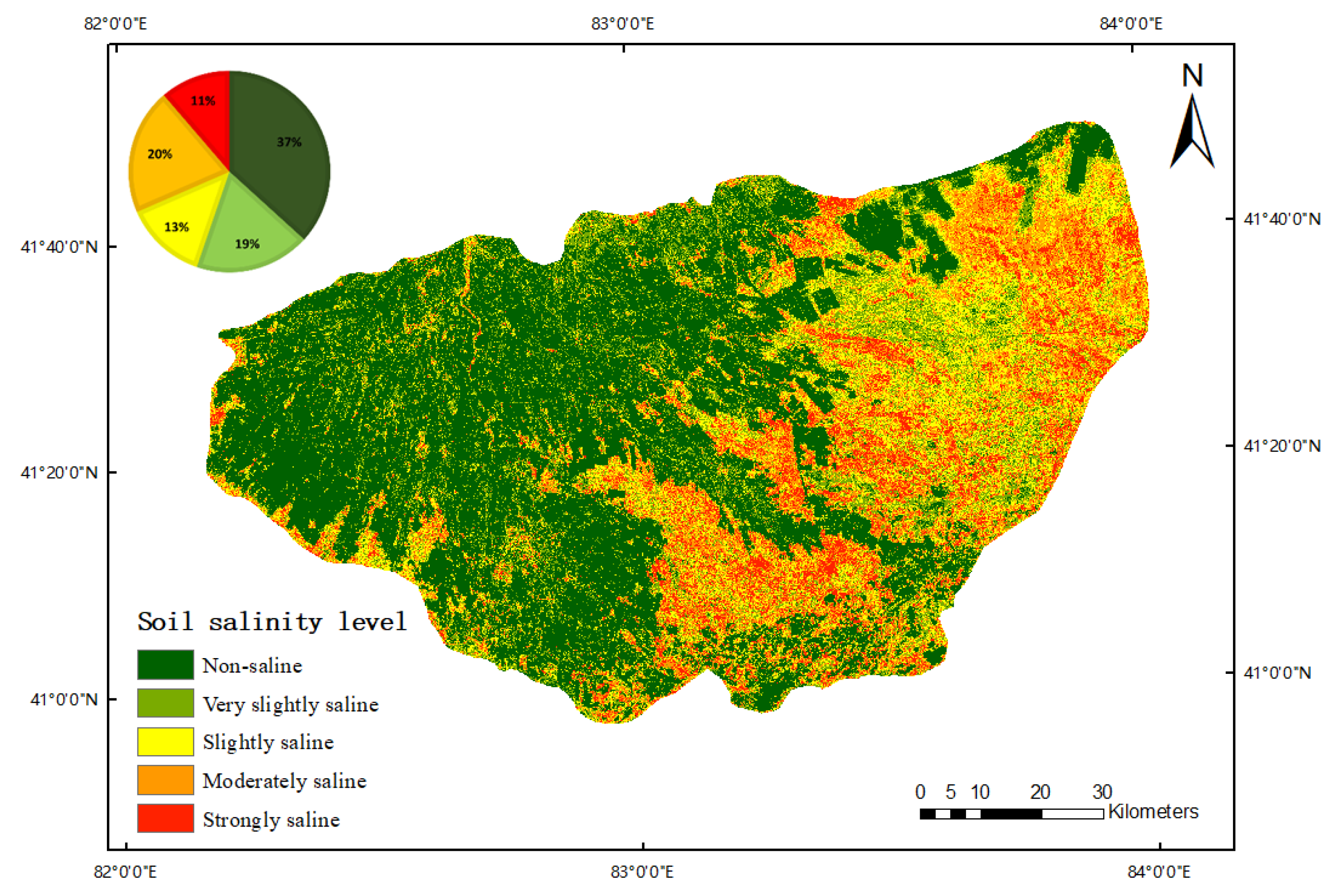



| Band | Description | Central Wavelength (nm) | Resolution (m) |
|---|---|---|---|
| band2 | blue | 490 | 10 m |
| band3 | green | 560 | 10 m |
| Band4 | red | 665 | 10 m |
| Band5 | Red edg1 | 705 | 20 m |
| Band6 | Red edg2 | 740 | 20 m |
| Band7 | Red edg3 | 783 | 20 m |
| Band8 | Near-infrared | 842 | 10 m |
| Band11 | Short wave infraed1 | 1610 | 20 m |
| Band12 | Short wave infraed2 | 2190 | 20 m |
| Auxiliary | Spectral Index | Acronym | Formula | Reference |
|---|---|---|---|---|
| Vegetation Index | Normalized Difference Vegetation Index | NDVI | [24] | |
| Enhanced Normalized Difference Vegetation Index | ENDVI | [24] | ||
| Enhanced Vegetation Index | EVI | [24] | ||
| Extended Enhanced Vegetation Index | EEVI | [24] | ||
| Soil-Adjusted Vegetation Index | SAVI | [24] | ||
| Modified Soil-Adjusted Vegetation Index | MSAVI | [24] | ||
| Generalized Difference Vegetation Index | GDVI | [24] | ||
| Salinity Index | Salinity Index | SI | [24] | |
| Salinity Index 1 | SI1 | [24] | ||
| Salinity Index 2 | SI2 | [24] | ||
| Canopy Response Salinity Index | CRSI | [24] | ||
| Normalized Difference Salinity Index | NDSI | [24] | ||
| Gypsum Index | GYEX | [25] | ||
| Clay Index | CLEX | [25] | ||
| Red-Edge Band Index | Red edg1 NDSI | NDSIre1 | [26] | |
| Red edg2 NDSI | NDSIre2 | [26] | ||
| Red edg3 NDSI | NDSIre3 | [26] | ||
| Red edg1 DVI | DVIre1 | [26] | ||
| Red edg2 DVI | DVIre2 | [26] | ||
| Red edg3 DVI | DVIre3 | [26] | ||
| Red edg1 EVI | EVIre1 | [26] | ||
| Red edg2 EVI | EVIre2 | [26] | ||
| Red edg3 EVI | EVIre3 | [26] |
| Auxiliary | Environmental Covariates | Acronym | Reference |
|---|---|---|---|
| Topographic Index | Digital Elevation Model | DEM | SAGA GIS |
| Slope | Slope | ||
| Aspect | Aspect | ||
| Topographic Wetness Index | TWI | ||
| Valley Depth | VD | ||
| Stream Power Index | SPI | ||
| Plan Curvature | PC | ||
| Relative Slope Position | RSP | ||
| Topographic Position Index | TPI | ||
| Climatic Factor | Monthly Average Precipitation | PRE | [27] |
| Monthly Average Temperature | TEM | [28] | |
| Monthly Average Potential Evapotranspiration | PET | [28] | |
| Drought Index | R | [28] | |
| Soil Characteristics Factor | Soil Organic Carbon | SOC | [22] |
| pH Value | PH | [22] | |
| Cation Exchange Capacity | CEC | [22] | |
| Bulk Density | BD | [22] |
| EC Sample Data | Min | Max | Mean | SD | CV |
|---|---|---|---|---|---|
| whole data (n = 94) | 0.17 | 90.30 | 20.63 | 23.85 | 1.16 |
| Modelling Strategy | Number of Independent Variables | Model | Average of Training Set | Average of Validation Set | ||||
|---|---|---|---|---|---|---|---|---|
| Strategy I | 39 | LightGBM | 0.65 | 14.09 | 10.07 | 0.53 | 25.12 | 17.74 |
| SVM | 0.48 | 19.49 | 13.45 | 0.38 | 26.16 | 18.93 | ||
| ELM | 0.49 | 19.25 | 12.99 | 0.41 | 24.50 | 16.62 | ||
| Strategy II | 14 | LightGBM | 0.87 | 10.80 | 8.70 | 0.72 | 12.49 | 11.15 |
| SVM | 0.56 | 22.04 | 16.36 | 0.43 | 20.29 | 15.57 | ||
| ELM | 0.51 | 23.23 | 15.67 | 0.46 | 20.77 | 15.14 | ||
| Strategy III | 22 | LightGBM | 0.82 | 12.02 | 8.98 | 0.67 | 16.42 | 12.20 |
| SVM | 0.49 | 23.66 | 17.63 | 0.47 | 19.42 | 14.44 | ||
| ELM | 0.54 | 18.48 | 13.04 | 0.51 | 22.80 | 15.75 | ||
| Environmental Variables | Multicollinearity Testing | |
|---|---|---|
| Tolerance | VIF | |
| soc | 0.265 | 3.780 |
| PRE | 0.617 | 1.621 |
| PH | 0.191 | 5.228 |
| cec | 0.124 | 8.067 |
| TEM | 0.135 | 7.388 |
| SPI | 0.569 | 1.757 |
| Variables | Bandwidth | Mean | SD | Min | Median | Max |
|---|---|---|---|---|---|---|
| Intercept | 32 | −0.139 | 0.011 | −0.158 | −0.142 | −0.120 |
| soc | 87 | −0.339 | 0.029 | −0.381 | −0.312 | −0.297 |
| PRE | 91 | −0.228 | 0.016 | −0.255 | −0.239 | −0.201 |
| PH | 65 | 0.034 | 0.251 | −1.459 | 0.640 | 1.527 |
| cec | 85 | −0.312 | 0.017 | −2.653 | −0.177 | 2.637 |
| TEM | 85 | −0.307 | 0.019 | −0.335 | −0.306 | −0.276 |
| SPI | 65 | −0.173 | 0.129 | −2.829 | −0.770 | 1.167 |
Disclaimer/Publisher’s Note: The statements, opinions and data contained in all publications are solely those of the individual author(s) and contributor(s) and not of MDPI and/or the editor(s). MDPI and/or the editor(s) disclaim responsibility for any injury to people or property resulting from any ideas, methods, instructions or products referred to in the content. |
© 2024 by the authors. Licensee MDPI, Basel, Switzerland. This article is an open access article distributed under the terms and conditions of the Creative Commons Attribution (CC BY) license (https://creativecommons.org/licenses/by/4.0/).
Share and Cite
Du, D.; He, B.; Luo, X.; Ma, S.; Song, Y.; Yang, W. Spatio-Temporal Variation Analysis of Soil Salinization in the Ougan-Kuqa River Oasis of China. Sustainability 2024, 16, 2706. https://doi.org/10.3390/su16072706
Du D, He B, Luo X, Ma S, Song Y, Yang W. Spatio-Temporal Variation Analysis of Soil Salinization in the Ougan-Kuqa River Oasis of China. Sustainability. 2024; 16(7):2706. https://doi.org/10.3390/su16072706
Chicago/Turabian StyleDu, Danying, Baozhong He, Xuefeng Luo, Shilong Ma, Yaning Song, and Wen Yang. 2024. "Spatio-Temporal Variation Analysis of Soil Salinization in the Ougan-Kuqa River Oasis of China" Sustainability 16, no. 7: 2706. https://doi.org/10.3390/su16072706






